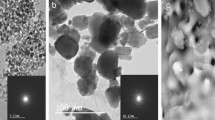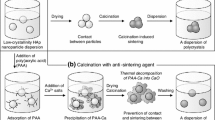Abstract
The purpose of this work was to compare hydroxyapatite (HAP) and composites of HAP, HAP with chitosan (CS), and HAP with poly(vinyl pyrrolidone) (PVP), in terms of their particle size and morphology, using different methods, such as Coulter counter analysis, X-ray diffraction (XRD), and transmission electron microscopy (TEM). Although many researchers have studied HAP and CS/HAP and PVP/HAP composites extensively, there is no evidence of a comparative study of their particle sizes. For this reason, different complementary methods have been used so as to provide a more complete image of final product properties — particle size — from the perspective of possible applications. The syntheses of HAP and HAP with polymer nanoparticles were carried out employing a precipitation method. Variation in particle size with synthesis time and influence of the reactants’ concentration on the materials’ preparation were systematically explored. Crystallite size calculated from XRD data revealed nanosized particles of HAP, CS/HAP, and PVP/HAP materials in the range of 2.5–9.2 nm. Coulter counter analysis revealed mean particle sizes of one thousand orders of magnitude larger, confirming that this technique measures agglomerates, not individual particles. In addition, the particles’ morphology and an assessment of their binding mode were completed by TEM measurements.
Similar content being viewed by others
References
Alatorre-Meda, M., Taboada, P., Hartl, F., Wagner, T., Freis, M., & Rodríguez, J. R. (2011). The influence of chitosan valence on the complexation and transfection of DNA: The weaker the DNA-chitosan binding the higher the transfection efficiency. Colloids and Surfaces B: Biointerfaces, 82, 54–62. DOI:10.1016/j.colsurfb.2010.08.013.
Burg, K. J. L., Porter, S., & Kellam, J. F. (2000). Biomaterial developments for bone tissue engineering. Biomaterials, 21, 2347–2359. DOI: 10.1016/s0142-9612(00)00102-2.
Cai, X., Tong, H., Shen, X. Y., Chen, W. X., Yan, J., & Hu, J. M. (2009). Preparation and characterization of homoge neous chitosan-polylactic acid/hydroxyapatite nanocomposite for bone tissue engineering and evaluation of its mechanical properties. Acta Biomaterialia, 5, 2693–2703. DOI:10.1016/j.actbio.2009.03.005.
Cao, L. Y., Zhang, C. B., & Huang, J. F. (2005). Influence of temperature, [Ca2+], Ca/P ratio and ultrasonic power on the crystallinity and morphology of hydroxyapatite nanoparticles prepared with a novel ultrasonic precipitation method. Materials Letters, 59, 1902–1906. DOI:10.1016/j.matlet.2005.02.007.
Chang, M. C., Ko, C. C., & Douglas, W. H. (2003). Preparation of hydroxyapatite-gelatin nanocomposites. Biomaterials, 24, 2853–2862. DOI: 10.1016/s0142-9612(03)00115-7.
Chen, F., Wang, Z. C., & Lin, C. J. (2002). Preparation and characterization of nano sized hydroxyapatite particles and hydroxyapatite/chitosan nano-composite for use in biomedical materials. Materials Letters, 57, 858–861. DOI: 10.1016/s0167-577x(02)00885-6.
Chen, F., Tang, Q. L., Zhu, Y. J., Wang, K. W., Zhang, M. L., Zhai, W. Y., & Chang, J. (2010). Hydroxyapatite nanorods/poly(vinyl pyrolidone) composite nanofibers, arrays and three-dimensional fabrics: Electrospun preparation and transformation to hydroxyapatite nanostructures. Acta Biomaterialia, 6, 3013–3020. DOI:10.1016/j.actbio.2010.02. 015.
Cheng, X. M., Li, Y. B., Zuo, Y., Zhang, L., Li, J. D., & Wang, H. A. (2009). Properties and in vitro biological evaluation of nano-hydroxyapatite/chitosan membranes for bone guided regeneration. Materials Science and Engineering: C, 29, 29–35. DOI:10.1016/j.msec.2008.05.008.
Cullity, B. D. (1978). Elements of X-ray diffraction. Reading, MA, USA: Addison-Wesley.
Dash, A. K., & Cudworth, G. C. (1998). Therapeutic applications of implantable drug delivery systems. Journal of Pharmacological and Toxicological Methods, 40, 1–12. DOI: 10.1016/s1056-8719(98)00027-6.
Di Martino, A., Sittinger, M., & Risbud, M. V. (2005). Chitosan: A versatile biopolymer for orthopaedic tissue-engineering. Biomaterials, 26, 5983–5990. DOI: 10.1016/j.biomaterials. 2005.03.016.
Ding, S. J. (2007). Biodegradation behavior of chitosan/calcium phosphate composites. Journal of Non-Crystalline Solids, 353, 2367–2373. DOI:10.1016/j.jnoncrysol.2007.04.020.
Dorozhkin, S. V., & Epple, M. (2002). Biological and medical significance of calcium phosphates. Angewandte Chemie International Edition, 41, 3130–3146. DOI: 10.1002/1521-3773(20020902)41:17〈3130::aid-anie3130〉3.0.co;2-1.
Du, X. W., Chu, Y., Xig, S. X., & Dong, L. H. (2009). Hydrothermal synthesis of calcium hydroxyapatite nanorods in the presence of PVP. Journal of Materials Science, 44, 6273–6279. DOI: 10.1007/s10853-009-3860-6.
Fábián, R., Kotsis, I., & Piltér, Z. (1999). Comparison of properties of fluorapatites prepared by solid state reaction and precipitation. Hungarian Journal of Industrial Chemistry, 27, 259–263.
Frake, P., Greenhalgh, D., Grierson, S. M., Hempenstall, J. M., & Rudd, D. R. (1997). Process control and end-point determination of a fluid bed granulation by application of near infra-red spectroscopy. International Journal of Pharmaceutics, 151, 75–80. DOI: 10.1016/s0378-5173(97)04894-1.
Francis Suh, J. K., & Matthew, H. W. T. (2000). Application of chitosan-based polysaccharide biomaterials in cartilage tissue engineering: a review. Biomaterials, 21, 2589–2598. DOI: 10.1016/s0142-9612(00)00126-5.
Gibson, I. R., Best, S. M., & Bonfield, W. (2002). Effect of silicon substitution on the sintering and microstructure of hydroxyapatite. Journal of the American Ceramic Society, 85, 2771–2777. DOI: 10.1111/j.1151-2916.2002.tb00527.x.
Halstensen, M., de Bakker, P., & Esbensen, K. H. (2006). Acoustic chemometric monitoring of an industrial granulation production process—a PAT feasibility study. Chemometrics and Intelligent Laboratory Systems, 84, 88–97. DOI:10.1016/j.chemolab.2006.05.012.
Harker, J. H., Backhurst, J. R., Richardson, J. F., & Coulson, J. M. (1991). Chemical engineering, Volume 2: Particle Technology and Separation Processes (4th ed.). Oxford, UK: Butterworth-Heinemann.
Hench, L. L., & Wilson, J. (1993). An introduction to bioceramics. Singapore, Singapore: World Scientific Publishing.
Hench, L. L. (1998). Bioceramics. Journal of the American Ceramic Society, 81, 1705–1728. DOI: 10.1111/j.1151-2916.1998.tb02540.x.
Hu, Q. L., Li, B. Q., Wang, M., & Shen, J. C. (2004). Preparation and characterization of biodegradable chitosan/hydroxyapatite nanocomposite rods via in situ hybridization: a potential material as internal fixation of bone fracture. Biomaterials, 25, 779–785. DOI: 10.1016/s0142-9612(03)00582-9.
Hu, X. H., Cunningham, J. C., & Winstead, D. (2008). Study growth kinetics in fluidized bed granulation with at-line FBRM. International Journal of Pharmaceutics, 347, 54–61. DOI:10.1016/j.ijpharm.2007.06.043.
Iafisco, M., Varoni, E., Battistella, E., Pietronave, S., Prat, M., Roveri, N., & Rimondini, L. (2010). The cooperative effect of size and crystallinity degree on the resorption of biomimetic hydroxyapatite for soft tissue augmentation. The International Journal of Artificial Organs, 33, 765–774.
Kandori, K., Fudo, A., & Ishikawa, T. (2000). Adsorption of myoglobin onto various synthetic hydroxyapatite particles. Physical Chemistry Chemical Physics, 2, 2015–2020. DOI: 10.1039/a909396f.
Khor, E., & Lim, L. Y. (2003). Implantable applications of chitin and chitosan. Biomaterials, 24, 2339–2349. DOI: 10.1016/s0142-9612(03)00026-7.
Klug, H. P., & Alexander, L. E. (1959). X-ray diffraction procedures. New York, NY, USA: Wiley.
Kong, L. J., Gao, Y., Cao, W. L., Gong, Y. D., Zhao, N. M., & Zhang, X. F. (2005). Preparation and characterization of nano-hydroxyapatite/chitosan composite scaffolds. Journal of Biomedical Materials Research Part A, 75A, 275–282. DOI: 10.1002/jbm.a.30414.
Li, J. J., Chen, Y. P., Yin, Y. J., Yao, F. L., & Yao, K. D. (2007). Modulation of nano-hydroxyapatite size via formation on chitosan-gelatin network film in situ. Biomaterials, 28, 781–790. DOI:10.1016/j.biomaterials.2006.09.042.
Manjubala, I., Ponomarev, I., Wilke, I., & Jandt, K. D. (2008). Growth of osteoblast like cells on biomimetic apatitecoated chitosan scaffolds. Journal of Biomedical Materials Research Part B: Applied Biomaterials, 84B, 7–16. DOI: 10.1002/jbm.b.30838.
Merkus, H. G. (2009). Particle size measurements: fundamentals, practice, quality. New York, NY, USA: Springer.
Murugan, R., & Ramakrishna, S. (2005). Crystallographic study of hydroxyapatite bioceramics derived from various sources. Crystal Growth & Design, 5, 111–112. DOI: 10.1021/cg034227s.
Nettles, D. L., Elder, S. H., & Gilbert, J. A. (2002). Potential use of chitosan as a cell scaffold material for cartilage tissue engineering. Tissue Engineering, 8, 1009–1016. DOI:10.1089/107632702320934100.
Oliveira, J. M., Rodrigues, M. T., Silva, S. S., Malafaya, P. B., Gomes, M. E., Viegas, C. A., Dias, I. R., Azevedo, J. T., Mano, J. F., & Reis, R. L. (2006). Novel hydroxyapatite/chitosan bilayered scaffold for osteochondral tissueengineering applications: Scaffold design and its performance when seeded with goat bone marrow stromal cells. Bioma terials, 27, 6123–6137. DOI:10.1016/j.biomaterials.2006.07.034.
Palazzo, B., Sidoti, M. C., Roveri, N., Tampieri, A., Sandri, M., Bertolazzi, L., Galbusera, F., Dubini, G., Vena, P., & Contro, R. (2005). Controlled drug delivery from porous hydroxyapatite grafts: An experimental and theoretical approach. Materials Science and Engineering: C, 25, 207–213. DOI:10.1016/j.msec.2005.01.011.
Park, J. H., Saravanakumar, G., Kim, K., & Kwon, I. C. (2010). Targeted delivery of low molecular drugs using chitosan and its derivatives. Advanced Drug Delivery Reviews, 62, 28–41. DOI:10.1016/j.addr.2009.10.003.
Peter, M., Ganesh, N., Selvamurugan, N., Nair, S. V., Furuike, T., Tamura, H., & Jayakumar, R. (2010). Preparation and characterization of chitosan-gelatin/nanohydroxyapatite composite scaffolds for tissue engineering applications. Carbohydrate Polymers, 80, 687–694. DOI: 10.1016/j.carbpol.2009.11.050.
Qiu, C. F., Xiao, X. F., Liu, R. F., & She, H. D. (2008). Biomimetic synthesis of spherical nano-hydroxyapatite with polyvinylpyrrolidone as template. Materials Science and Technology, 24, 612–617. DOI: 10.1179/174328407x176974.
Queiroz, A. C., Santos, J. D., Monteiro, F. J., Gibson, I. R., & Knowles, J. C. (2001). Adsorption and release studies of sodium ampicillin from hydroxyapatite and glass-reinforced hydroxyapatite composites. Biomaterials, 22, 1393–1400. DOI: 10.1016/s0142-9612(00)00296-9.
Ragetly, G., Griffon, D. J., & Chung, Y. S. (2010). The effect of type II collagen coating of chitosan fibrous scaffolds on mesenchymal stem cell adhesion and chondrogenesis. Acta Biomaterialia, 6, 3988–3997. DOI:10.1016/j.actbio.2010.05.016.
Rusu, V. M., Ng, C. H., Wilke, M., Tiersch, B., Fratzl, P., & Peter, M. G. (2005). Size-controlled hydroxyapatite nanoparticles as self-organized organic-inorganic composite materials. Biomaterials, 26, 5414–5426. DOI: 10.1016/j.biomaterials.2005.01.051.
Şentürk, S. B., Kahraman, D., Alkan, C., & Gokçe, İ. (2011). Biodegradable PEG/cellulose PEG/agarose and PEG/chitosan blends as shape stabilized phase change materials for latent heat energy storage. Carbohydrate Polymers, 84, 141–144. DOI:10.1016/j.carbpol.2010.11.015.
Suchanek, W., & Yoshimura, M. (1998). Processing and properties of hydroxyapatite-based biomaterials for use as hard tissue replacement implants. Journal of Materials Research, 13, 94–117. DOI:10.1557/jmr.1998.0015.
Teng, S. H., Lee, E. J., Yoon, B. H., Shin, D. S., Kim, H. E., & Oh, J. S. (2009). Chitosan/nanohydroxyapatite composite membranes via dynamic filtration for guided bone regeneration. Journal of Biomedical Materials Research: Part A, 88A, 569–580. DOI:10.1002/jbm.a.31897.
Thein-Han, W. W., & Misra, R. D. K. (2009). Biomimetic chitosan-nanohydroxyapatite composite scaffolds for bone tissue engineering. Acta Biomaterialia, 5, 1182–1197. DOI:10.1016/j.actbio.2008.11.025.
Tonegawa, T., Ikoma, T., Yoshioka, T., Chen, G. P., Hanagata, N., & Tanaka, J. (2008). Characterization and protein adsorption ability of zinc, iron and magnesium hydroxyapatite. Key Engineering Materials, 361–363, 187–190. DOI: 10.4028/www.scientific.net/kem.361-363.187.
Washington, C. (1992). Particle size analysis in pharmaceutics and other industries: Theory and practice. Chichester, UK: Ellis Horwood.
Yamaguchi, I., Tokuchi, K., Fukuzaki, H., Koyama, Y., Takakuda, K., Monma, H., & Tanaka, J. (2001). Preparation and microstructure analysis of chitosan/hydroxyapatite nanocomposites. Journal of Biomedical Materials Research: Part A, 55, 20–27. DOI: 10.1002/1097-4636(200104)55:1〈20::aidjbm30〉3.0.co;2-f.
Yang, Q., Wang, J. X., Guo, F., & Chen, J. F. (2010). Preparation of hydroxyapatite nanoparticles by using high-gravity reactive precipitation combined with hydrothermal method. Industrial & Engineering Chemistry Research, 49, 9857–9863. DOI: 10.1021/ie1012757.
Zhang, Y. Z., Venugopal, J. R., El-Turki, A., Ramakrishna, S., Su, B., & Lim, C. T. (2008). Electrospun biomimetic nanocomposite nanofibers of hydroxyapatite/chitosan for bone tissue engineering. Biomaterials, 29, 4314–4322. DOI:10.1016/j.biomaterials.2008.07.038.
Author information
Authors and Affiliations
Corresponding author
Rights and permissions
About this article
Cite this article
Barabás, R., Czikó, M., Dékány, I. et al. Comparative study of particle size analysis of hydroxyapatite-based nanomaterials. Chem. Pap. 67, 1414–1423 (2013). https://doi.org/10.2478/s11696-013-0409-6
Received:
Revised:
Accepted:
Published:
Issue Date:
DOI: https://doi.org/10.2478/s11696-013-0409-6




